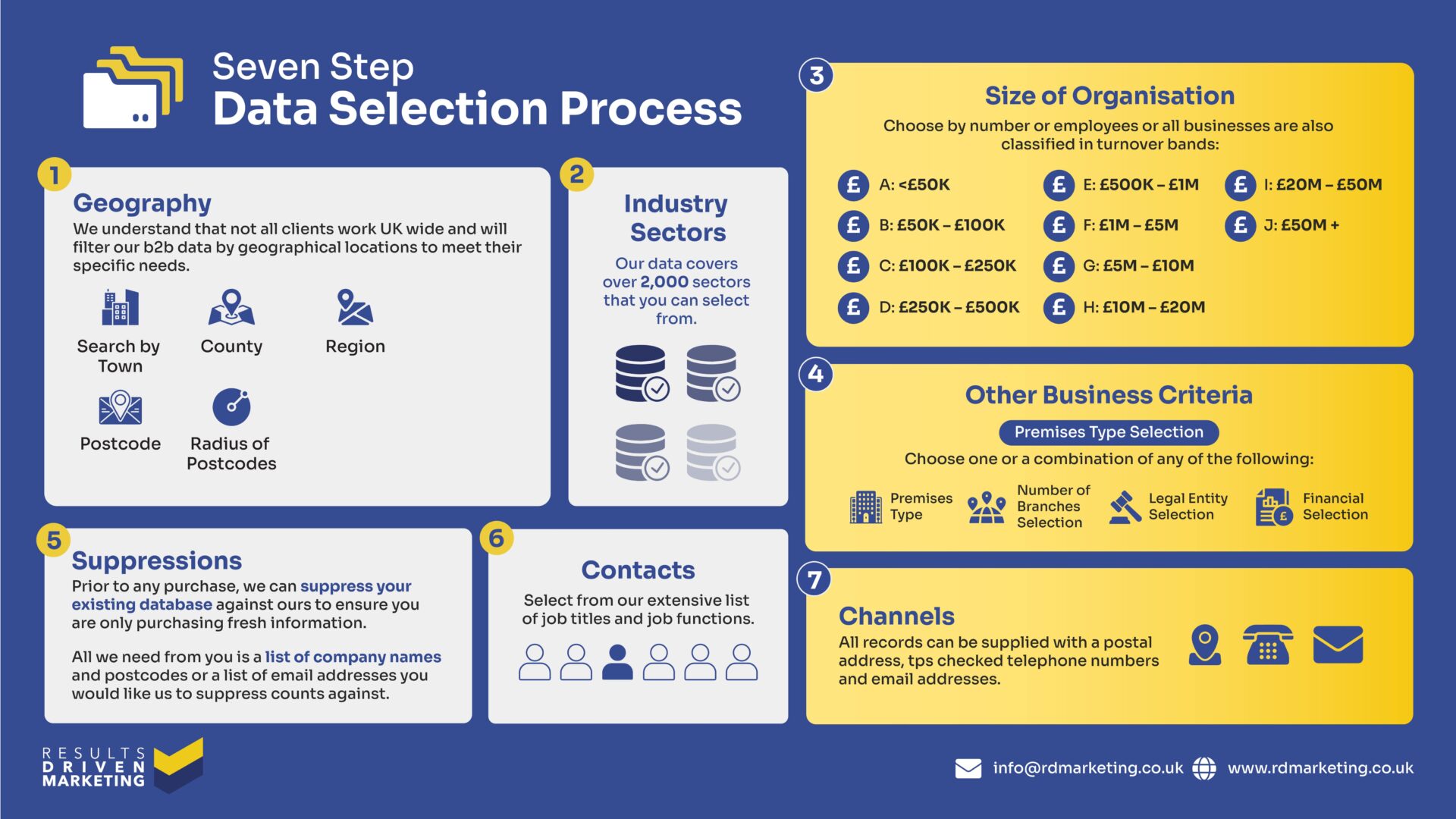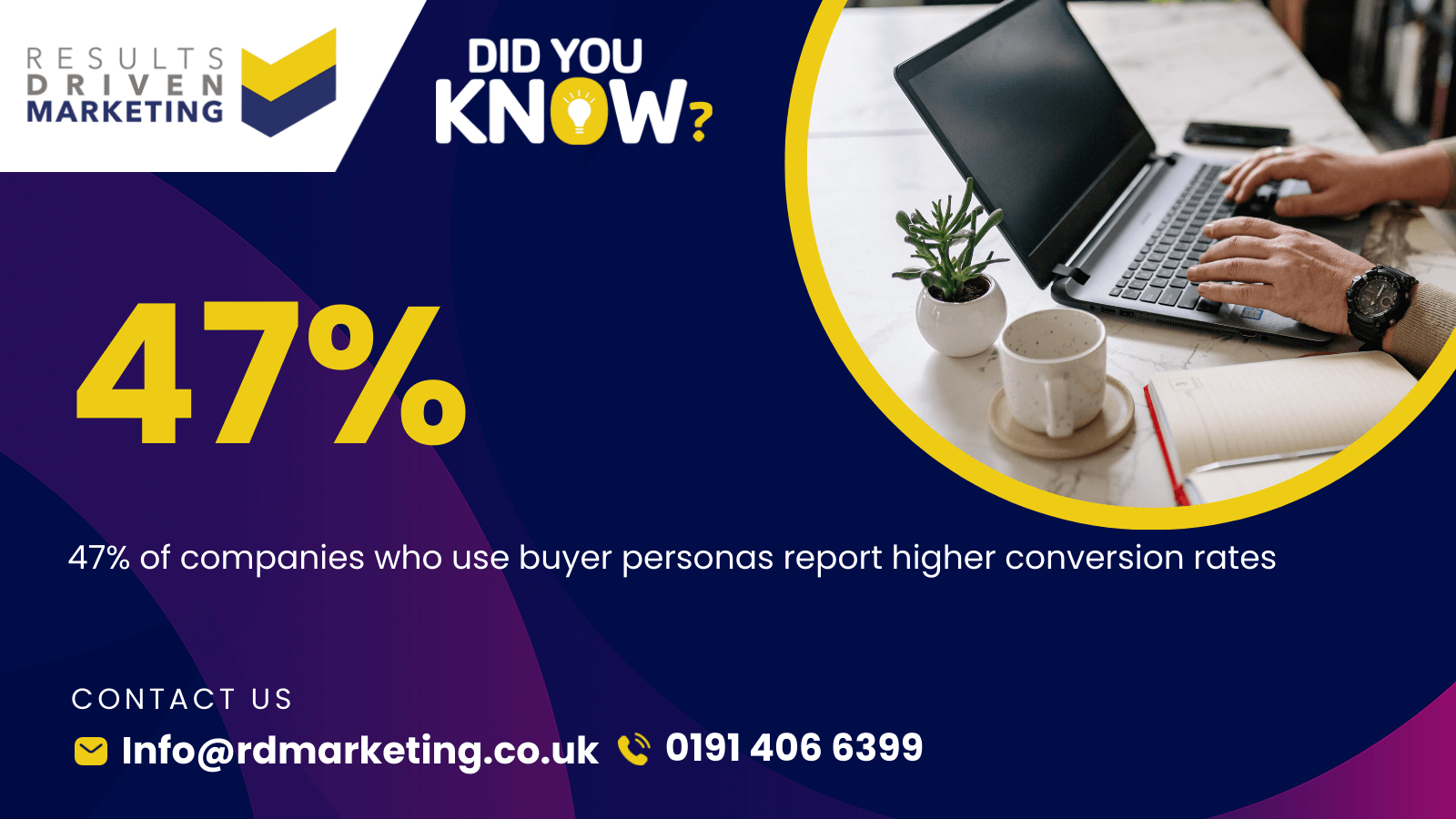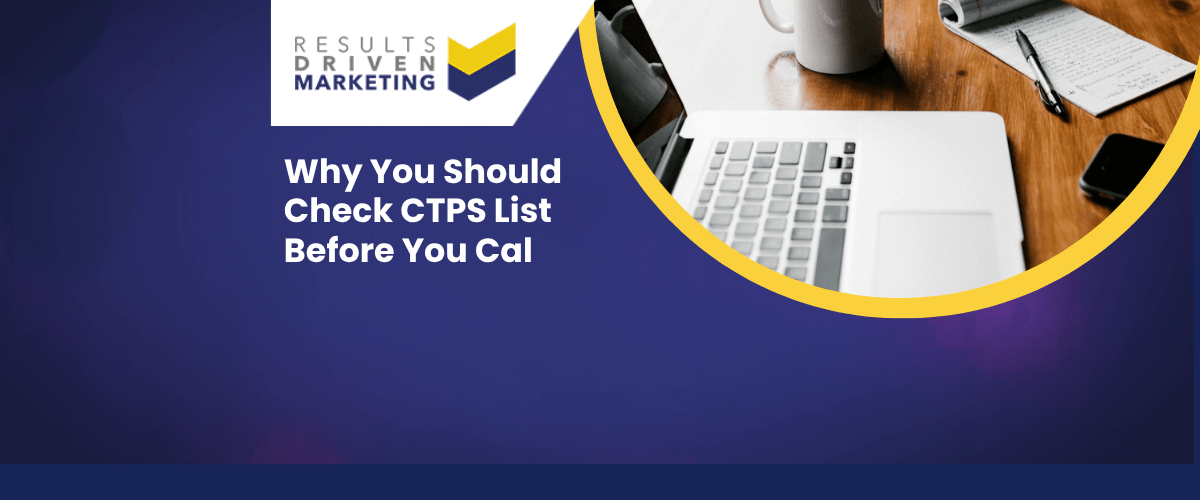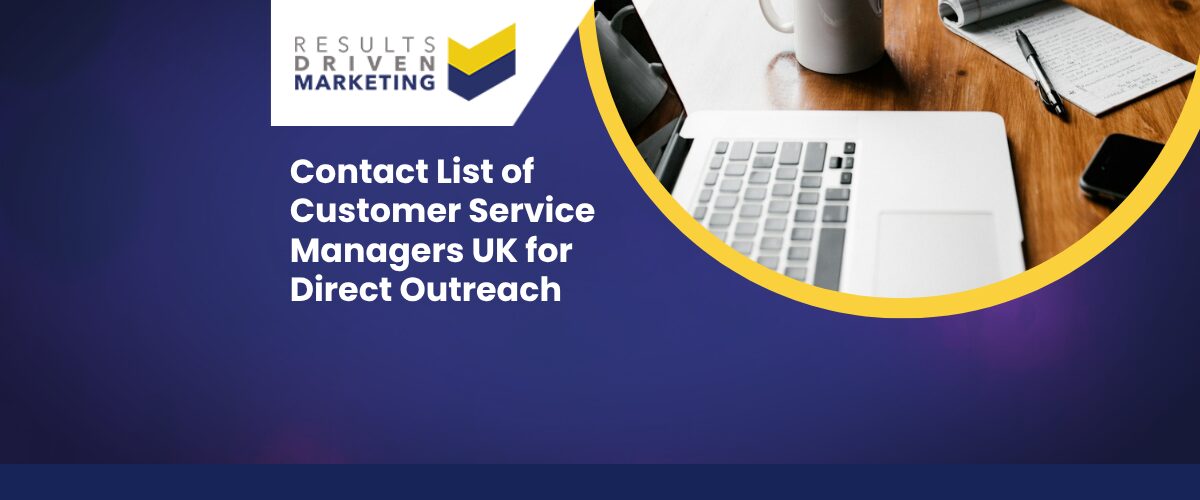
What is a Buyer Persona?
Buyer personas provide a roadmap for creating more personalised, effective marketing strategies. They help businesses like yours tailor their messaging, products, and services to meet the needs of specific customer groups. Whether you’re reaching out through email campaigns, telemarketing, or direct mail, understanding your audience on a deeper level can make all the difference.
For example, at RD Marketing, we offer B2B Data and Direct Mail Data that enable businesses to precisely target their audiences. When combined with a detailed buyer persona, these tools can significantly boost ROI and drive meaningful engagement.
But why is knowing your audience so crucial? A well-defined buyer persona allows you to:
- Speak directly to your audience’s pain points.
- Anticipate their needs and offer timely solutions.
- Create marketing materials that resonate on a personal level.
By leveraging insights from tools like our CTPS Checker or Email Marketing Management Services, businesses can refine their approach and ensure their message reaches the right people at the right time.
Ultimately, understanding what is a buyer persona isn’t just about improving your marketing—it’s about building stronger relationships with your customers. Ready to get started? Let’s dive deeper into how buyer personas can transform your strategy.
Table of contents:
What is a Buyer Persona?
A buyer persona is more than just a marketing buzzword—it’s a vital tool for understanding your customers on a deeper level. But what is a buyer persona? It’s essentially a semi-fictional profile that represents your ideal customer, created using a mix of real data, research, and insights into their behaviors, challenges, and needs. Unlike broad demographic targeting, a buyer persona dives deeper, giving you a clearer picture of who your audience is and what drives their decisions.
Buyer personas play a crucial role in both marketing and sales by providing a foundation for personalised communication. Instead of relying on generic messaging, businesses can tailor their strategies to address the specific pain points and goals of their audience. For instance, when you’re targeting decision-makers in a particular industry, services like our Telemarketing Data can complement your buyer persona research by helping you connect directly with the right people.
Here’s how a buyer persona differs from basic demographic targeting:
- Demographic Targeting: Focuses on general traits like age, gender, location, or income.
- Buyer Persona: Goes deeper, including motivations, pain points, buying habits, and preferred communication channels.
For example, a demographic segment might target “working professionals aged 30-40,” while a buyer persona would outline “HR managers at mid-sized companies who prioritise cost-effective employee benefits and prefer email communication.”
When you pair a detailed buyer persona with services like our B2B Data or Data Cleansing Services, you gain the ability to reach your audience with pinpoint accuracy. Whether you’re crafting an email campaign or planning direct mail outreach, knowing your buyer persona ensures your efforts resonate with the right people.
In short, understanding what is a buyer persona allows businesses to connect with their customers on a more meaningful level. It’s the difference between speaking at your audience and having a conversation with them.
Why Are Buyer Personas Important?
Understanding the importance of buyer personas is key to building successful marketing and sales strategies. By creating detailed profiles of your ideal customers, you gain the insights needed to craft messaging and products that truly resonate. But what exactly makes buyer personas so essential? Let’s explore the key benefits.
More Personalised Marketing
One of the biggest advantages of creating buyer personas is the ability to personalise your marketing efforts. Instead of generic campaigns, you can tailor your messaging to address the specific needs, preferences, and challenges of your target audience. For instance, if your buyer persona prefers email communication, you can leverage tools like our Email Address List Data to send them targeted campaigns that feel personal and relevant.
Example: A company targeting small business owners might create a campaign focused on cost-effective solutions, highlighting specific benefits that matter most to that group.
Better Product Development
Buyer personas don’t just help with marketing; they also guide product development. When you understand what your customers truly need, you can create products and services that solve their pain points. For example, using our Consumer Data, you can gather insights to develop solutions tailored to your audience’s unique preferences.
Example: If your persona includes parents looking for eco-friendly products, you can prioritise sustainable materials in your offerings.
Enhanced Customer Experience
Providing a seamless customer experience starts with knowing your audience. Buyer personas allow you to anticipate their expectations and deliver experiences that make them feel understood and valued. Whether it’s through personalised content or streamlined customer support, personas help you create lasting connections.
Example: A persona that prefers phone interactions can benefit from using our Telemarketing Data to provide timely and engaging support.
Scenarios Where Buyer Personas Make a Difference
- Marketing Campaigns: Businesses can segment their audience and deliver targeted ads using services like B2B Data or Direct Mail Data.
- Email Campaigns: Personas help determine the tone, content, and timing of emails, maximising engagement through tools like Email Marketing Management Services.
- Expanding Reach: With an International Email List, businesses can target global audiences more effectively by aligning campaigns with cultural nuances.
Components of a Buyer Persona
So, now that we’ve got the basics of what is a buyer persona down, let’s dive deeper into its components. Creating a buyer persona isn’t just about putting a name to a face; it’s about understanding the person you’re trying to reach on a much deeper level. A well-rounded buyer persona includes several key elements that help you visualise and segment your ideal customer.
Here’s a breakdown of the essential components that make up a buyer persona:
Demographics
Demographics are usually the first thing we think about when we talk about a target audience, and for good reason. These are the basic characteristics that define who your customer is on a surface level. Some of the most common demographic details to include in your buyer persona are:
- Age: Are they in their 20s, 30s, 40s, or beyond?
- Location: Where do they live? Are they local, national, or international?
- Job Title/Role: What is their job title? Are they decision-makers, influencers, or end-users?
- Income Level: Do they have the budget for your products or services?
For example, if you’re selling B2B data services like those offered by RD Marketing, your buyer persona might include business professionals from various industries looking to enhance their data strategies or improve customer targeting.
Psychographics
Now, while demographics help define who your customer is, psychographics give you the “why” behind their decisions. This is where you really get to know your persona’s motivations, interests, and values. Some key psychographic factors to consider are:
- Values: What do they care about? Are they interested in sustainability, community, or innovation?
- Lifestyle: How do they spend their time outside of work? Do they prioritise family, fitness, or travel?
- Interests: What hobbies or passions influence their decision-making?
Understanding these psychographics is crucial for crafting targeted campaigns. For example, someone interested in digital marketing and improving their email strategies might be more inclined to check out email marketing management services.
Pain Points and Challenges
Every buyer persona has their own unique set of challenges and pain points. By identifying these obstacles, you can better position your product or service as the solution. Some typical pain points might include:
- Lack of time: Your persona may be overwhelmed and looking for ways to streamline processes.
- Inefficiency: Perhaps they struggle with outdated systems or inefficient workflows.
- Cost: Maybe they’re looking for ways to cut costs while still maintaining quality.
When you understand these challenges, you can create marketing content that speaks directly to their needs. For instance, businesses struggling with poor data quality might benefit from data cleansing services that improve accuracy and lead generation.
Goals and Objectives
Buyer personas also have specific goals and aspirations, which are often closely tied to their professional and personal objectives. These goals might include:
- Career Advancement: Your persona might be looking for tools or strategies that will help them succeed at work and climb the corporate ladder.
- Increased Efficiency: They may seek solutions that save time or reduce the hassle of manual tasks.
- Profit Growth: For B2B personas, increasing sales or improving marketing ROI could be top priorities.
When developing a buyer persona, ask yourself: What does success look like for this person? For instance, a business owner aiming to enhance their marketing efforts might find our email address list data incredibly valuable.
Buying Behavior and Decision-Making Process
Last but definitely not least, we need to understand how your persona buys. Their decision-making process is crucial because it tells you how and why they make a purchase. Consider these factors when defining your buyer persona:
- Decision-making style: Are they impulsive or do they take their time? Do they involve others in the decision-making process?
- Information sources: Where do they turn for advice? Do they rely on online reviews, case studies, or word-of-mouth?
- Buying triggers: What events or experiences push them to make a purchase? Perhaps a need for better data, improved customer engagement, or faster lead generation.
Understanding their buying behavior can help you create targeted messaging and tailor your approach. For example, if they are actively seeking solutions to optimise their marketing campaigns, our international email list could be the perfect fit to enhance their outreach strategy.
How to Create a Buyer Persona
So, now that we know what is a buyer persona and why they’re essential for your marketing strategy, let’s take a look at how you can actually create one. Creating a detailed and accurate buyer persona isn’t an overnight process, but with the right steps, you’ll be able to put together a persona that truly resonates with your target audience.
Let’s break it down into a simple, step-by-step guide:
Collect Customer Data
The first step in creating a buyer persona is gathering as much relevant data as possible. You’ll want to collect both qualitative and quantitative data to ensure that your persona is grounded in real-world insights. Some of the best sources for this data include:
- Surveys: Send out surveys to your existing customers and potential customers. Ask about their demographics, challenges, goals, and purchasing decisions.
- Interviews: Conduct one-on-one interviews with your target audience or current customers. This will give you deeper insights into their thoughts, motivations, and behaviors.
- Analytics: Use tools like Google Analytics to gather demographic data, website behavior, and traffic sources. You can even analyse how visitors engage with your content and which products or services they are most interested in.
If you need help identifying potential customers or refining your data collection, RD Marketing offers a range of services such as B2B data, consumer data, and telemarketing data to help you gather valuable customer insights.
Identify Patterns in Behavior and Demographics
Once you have gathered your data, the next step is to sift through it and start looking for patterns. This is where you’ll begin to spot the common characteristics and behaviors that define your ideal customer.
- Demographics: Identify patterns in basic demographics such as age, gender, income level, job title, and location.
- Behavioral Insights: Look for trends in how customers behave. For example, do they often purchase online or in-store? Do they prefer mobile or desktop shopping? What content do they engage with most on your website?
When you can spot these trends, you can start to create a clearer picture of who your ideal customers are. If you need more data to identify these patterns, tools like CTPS checker or data enrichment services can be useful to gain further insights into customer preferences and behaviors.
Develop Distinct Personas Based on This Data
At this stage, you should have a wealth of information about your audience. The next step is to organise this information into distinct buyer personas. You may end up with more than one persona depending on your customer base, and that’s perfectly fine. In fact, it’s better to have multiple personas that represent different segments of your target market.
Each persona should include:
- Name: Give your persona a name that helps humanise them (e.g., “Tech-Savvy Tom” or “Budget-Conscious Brenda”).
- Demographics: Include details such as age, job role, income, and location.
- Challenges: Identify what problems they’re trying to solve with your product or service.
- Goals: Highlight their personal or professional objectives.
- Buying Behavior: Understand how they make purchasing decisions.
If you’re struggling to create personas or need help refining them, RD Marketing offers services like direct mail data and international email lists that can assist in targeting the right segments.
Validate Personas with Real Customer Feedback
Once you’ve created your buyer personas, it’s crucial to validate them with real customer feedback. After all, no persona is accurate unless it’s backed by genuine insights from actual customers. Here are some ways you can validate your personas:
- Surveys and Interviews: Go back to your audience and ask for feedback on your personas. Are they accurate? Do they match how your customers view themselves?
- Customer Service Data: Look at data from your customer support or sales team. Do they see the same challenges and needs that you’ve identified in your personas?
- Social Media Feedback: Monitor social media interactions to get a sense of what your audience truly cares about.
By validating your personas with real feedback, you can make sure they truly reflect the needs and desires of your target audience. If you want to further refine your personas with data, our email marketing management services and data cleansing services can help ensure that your data is accurate and up-to-date.
Use Personas to Inform Marketing Campaigns
Finally, once your personas are ready and validated, it’s time to put them to work. Use them to guide every aspect of your marketing strategy. Here’s how personas can help you:
- Content Creation: Tailor your blog posts, social media content, and email campaigns to address the specific needs and challenges of each persona.
- Targeting: Use personas to refine your targeting in advertising campaigns. For example, you might use email address list data to segment your audience by persona, allowing you to deliver more relevant messaging.
- Product Development: Personas can also inform your product offerings, ensuring you’re meeting the needs and expectations of your target market.
When you use your buyer personas to guide your marketing decisions, you’ll create more effective campaigns that resonate with your audience and lead to better business outcomes.
Common Mistakes to Avoid When Creating Buyer Personas
When it comes to creating buyer personas, there are a few common pitfalls that businesses tend to stumble into. As powerful as buyer personas are, getting them wrong can lead to wasted time, resources, and less effective marketing campaigns.
So, let’s look at some of the biggest mistakes you should avoid when crafting your personas—and, of course, how to sidestep them entirely.
Creating Too Many Personas
One of the most common mistakes people make when they first dive into creating buyer personas is making too many of them. While it might feel like you’re covering all your bases by developing a persona for every little niche, having too many can quickly dilute your focus.
Over-segmentation can make your marketing strategies scattered and less effective because you’re trying to speak to too many people at once.
How to avoid this: Focus on creating primary personas that represent your most important customer segments. You can always create a secondary persona or two for broader targeting, but keep it concise and only create personas that genuinely add value to your strategy.
It’s better to have a few strong, well-researched personas than 10 weak ones that spread your efforts too thin.
For instance, when running a campaign using B2B data or telemarketing data, having one or two clearly defined buyer personas will help you craft personalised messages that resonate deeply with your audience, as opposed to juggling multiple personas with vague needs.
Relying on Assumptions Instead of Data
Another big mistake? Creating personas based solely on assumptions or gut feelings rather than actual data. While it’s easy to think you “know” your customer, relying on guesses can lead to inaccuracies and poor targeting. Your personas will be far more powerful if they’re built using real insights from actual customers.
How to avoid this: Use real data to drive your buyer persona development. Gather insights from customer surveys, interviews, website analytics, and sales data.
Utilising tools like data enrichment services can help you gather more comprehensive and reliable information about your customers, giving you the detail you need to create precise, effective personas.
If you’re launching a new campaign, consider purchasing direct mail data or email list data to support your research and further understand your audience’s behaviour, preferences, and pain points.
Not Updating Your Buyer Personas Regularly
The market changes. Your customers evolve. A persona that worked brilliantly last year may not be as relevant today.
One mistake that businesses often make is assuming that buyer personas are a “set-it-and-forget-it” tool. But that couldn’t be further from the truth.
How to avoid this: Make it a habit to review and update your buyer personas regularly. Customer behaviours change, and so should your personas.
For example, use data cleansing services to ensure your customer information remains accurate and up-to-date. Regular reviews and tweaks will keep your personas fresh and aligned with the latest market trends.
Also, if you’re expanding to new regions, an international email list might require you to develop slightly different personas to reflect the cultural and demographic differences across different markets. This kind of dynamic persona update is essential for staying competitive.
Ignoring Negative or Exclusionary Personas
Many businesses fail to create negative personas, which represent the types of customers you don’t want to target. Without a negative persona, you might end up marketing to the wrong people—people who are not a good fit for your products or services and who waste your team’s time and resources.
How to avoid this: Create exclusionary personas to identify who isn’t a good fit for your product. These personas help you focus on high-value prospects while avoiding those unlikely to convert.
By refining your targeting—whether you’re using consumer data, CTPS checker for compliance, or any other tool—you can significantly improve the quality of your leads.
Failing to Integrate Personas Across Your Marketing Strategy
Even the best buyer personas won’t make an impact if they’re just sitting in a document somewhere and not being actively integrated into your marketing strategy.
Some businesses fail to use personas to shape their content, email marketing, or even product development, and this leaves them under-leveraged.
How to avoid this: Make sure everyone in your organisation understands your buyer personas and uses them when creating campaigns, especially in key areas like email marketing management services or product messaging. Personalise your content and tailor your outreach based on the specific goals, challenges, and preferences of your personas.
For example, if you’re targeting a particular persona through an email marketing campaign, referencing their unique pain points or goals can drastically improve engagement rates.
By avoiding these common mistakes and using the right tools—whether that’s data enrichment, B2B data, or any other service—you can ensure your buyer personas are accurate, actionable, and always aligned with your business goals.
Need help crafting or refining your buyer personas? Visit RD Marketing to explore how our data services, including consumer data and telemarketing data, can give you the insights you need to build stronger, more effective buyer personas.
How to Use Buyer Personas in Your Marketing Strategy
Buyer personas are not just a theoretical concept—they are a practical tool that can transform the way you connect with your audience. When you understand what a buyer persona is and apply it effectively, you can align your marketing efforts with the needs, challenges, and preferences of your ideal customers. Here’s how to incorporate buyer personas into your marketing strategy.
Refine Your Targeting Across Channels
A clear understanding of your buyer persona helps you target the right audience with precision.
- Email Campaigns: Use your personas to segment email lists and craft personalised messages that address specific pain points. Tools like Email Marketing Management Services from RD Marketing simplify this process, ensuring your campaigns are both targeted and efficient.
- Direct Mail: Buyer personas can guide you in creating impactful direct mail pieces. Leverage Direct Mail Data from RD Marketing to ensure your mailing list aligns with the audience you want to reach.
Craft Tailored Messaging
Your marketing message should resonate with your audience’s goals and challenges.
- Create content that speaks directly to their motivations. For instance, if one persona values cost-efficiency, highlight affordable solutions in your messaging.
- Use your buyer personas to develop personalised calls to action (CTAs) that prompt engagement.
- To ensure your data is accurate and up-to-date for crafting messages, consider Data Cleansing Services from RD Marketing. Clean data results in more effective communication.
Optimise Content Marketing
Content marketing is a powerful way to engage your personas at various stages of their buyer journey.
- Top of Funnel (Awareness): Create blog posts, infographics, and videos that address general problems faced by your personas. For example, “What is a Buyer Persona?” could be an excellent awareness-stage piece for educating potential clients.
- Middle of Funnel (Consideration): Use whitepapers, case studies, and webinars to showcase how your services address specific challenges.
- Bottom of Funnel (Decision): Highlight testimonials and product demos to solidify trust and encourage conversions.
For effective outreach, Telemarketing Data from RD Marketing can support your persona-driven campaigns.
Align Sales and Marketing Teams
A well-defined buyer persona ensures that both your sales and marketing teams work towards a shared understanding of your audience.
- Use personas to align your lead generation strategies with sales follow-ups.
- Share detailed insights from personas to help your sales team anticipate client objections and preferences.
- Leverage tools like B2B Data from RD Marketing to supply both teams with reliable and actionable leads.
Personalise Multi-Channel Campaigns
Implementing buyer personas across multiple marketing channels ensures a cohesive customer experience.
- Social Media: Share content that appeals to specific personas on the platforms they frequent.
- Email Marketing: Segment your audience by persona traits using an Email Address List from RD Marketing.
- Paid Advertising: Use persona data to refine audience targeting in PPC campaigns. Tools like International Email Lists from RD Marketing can also help expand your reach globally.
Measure and Adjust Your Strategy
The success of any marketing strategy depends on continuous measurement and improvement.
- Monitor KPIs such as engagement rates, conversion rates, and ROI for each persona-driven campaign.
- Regularly update your personas based on performance data and feedback.
- Utilise tools like the CTPS Checker from RD Marketing to ensure your telemarketing campaigns comply with legal requirements while maintaining accurate audience data.
Who are we?
Thinking about “how do I buy data“?
Providing b2b database solutions is our passion.
Offering a consultancy service prior to purchase, our advisors always aim to supply a database that meets your specific marketing needs, exactly.
We also supply email marketing solutions with our email marketing platform and email automation software.
Results Driven Marketing have the best data of email lists for your networking solutions as well as direct mailing lists & telemarketing data in telemarketing lists
We provide data cleansing and data enrichment services to make sure you get the best data quality.
We provide email marketing lists and an international email list for your business needs.
At RDM We provide b2c data as we have connections with the best b2c data brokers.
A good quality b2b database is the heartbeat of any direct marketing campaign…
It makes sense to ensure you have access to the best!
Call us today on 0191 406 6399 to discuss your specific needs.
Results Driven Marketing
0191 406 6399









